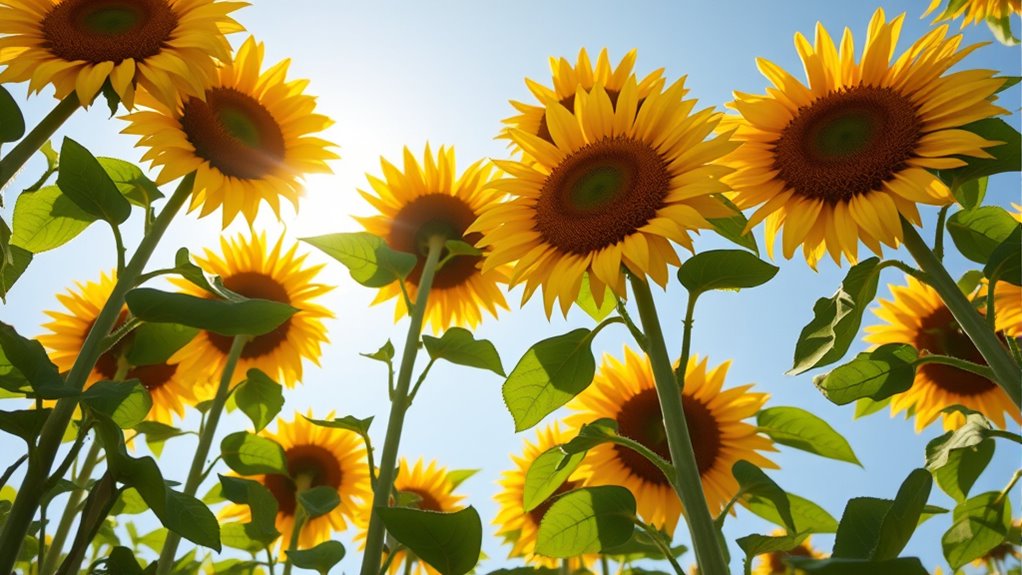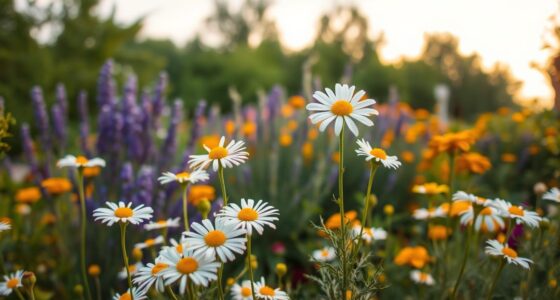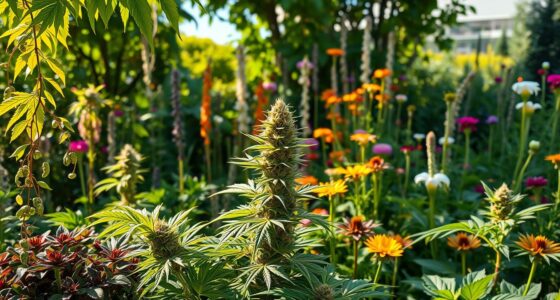Plantting climbing beans at the base of tall sunflowers creates a natural trellis that maximizes space and boosts pollination. Sunflowers attract bees, which improves bean fertilization and seed production. To get the best results, guarantee rich, well-draining soil and support pollinator activity with flowers or bee habitats. Keep soil moist with deep watering and mulch to promote healthy growth. Keep exploring for more tips to help your garden thrive with this sky-high companion trick.
Key Takeaways
- Plant climbing beans at the base of tall sunflowers to use their stalks as natural trellises.
- Encourage bee activity by planting nearby flowering plants to improve pollination and seed production.
- Use well-draining, organic-rich soil with balanced nutrients, avoiding excessive nitrogen fertilizer.
- Maintain consistent watering and mulch to conserve moisture and promote healthy growth.
- Support pollinators with bee-friendly blooms and nesting sites for better pollination and higher yields.

Have you ever wondered how sunflowers and beans can thrive together in your garden? The secret lies in understanding how to optimize their growth through proper pollination techniques and soil preparation tips. When you plant these two together, you’re creating a natural symbiosis that benefits both plants, but it requires some knowledge and effort on your part.
First, focus on pollination techniques to ensure your sunflowers and beans produce abundant flowers and healthy seeds. Sunflowers are primarily pollinated by bees, and attracting these pollinators can considerably boost your crop yield. To do this, plant flowers that attract bees nearby, such as lavender or wildflowers. Make sure your garden has a variety of blooms to support pollinators throughout the growing season. For beans, especially if you’re growing climbing varieties, hand-pollination can be beneficial if bee activity is low. Gently transferring pollen from the male to female flowers will improve fertilization and increase pod production. Remember, healthy pollination directly impacts the success of your plants, so pay attention to bee activity and consider providing bee hotels or nesting sites to encourage them to visit your garden more frequently.
Enhance sunflower and bean yields with targeted pollination and attracting bees through garden blooms and nesting sites.
Next, soil preparation tips are critical when planting sunflowers and beans together. Both plants thrive in well-draining soil rich in organic matter, so start by loosening the soil thoroughly before planting. Incorporate compost or aged manure to boost soil fertility and provide essential nutrients. Sunflowers prefer slightly alkaline soil, so testing your soil pH and adjusting it if necessary can help them grow taller and stronger. Beans, on the other hand, are legumes that fix nitrogen in the soil, which benefits sunflowers by increasing nutrient availability. Thus, avoid excessive nitrogen fertilizers that could promote lush foliage at the expense of flower production. Instead, focus on building a balanced soil environment that supports both plants’ needs.
Additionally, consider the planting arrangement to maximize their benefits. Since sunflowers grow tall and act as natural trellises, plant beans at the base of the sunflowers early in the season, allowing them to climb upward. This vertical growth not only saves space but also creates a microclimate that can help retain soil moisture and suppress weeds. Water your plants deeply and consistently, especially during dry spells, to keep the soil moist but not waterlogged. Mulching around the base of the plants helps maintain soil moisture, regulate temperature, and reduce weed growth.
Frequently Asked Questions
Can Sunflowers and Beans Be Grown Together in Small Garden Spaces?
Yes, you can grow sunflowers and beans together in small garden spaces. To make it work, plan your garden layout to give each plant enough room and support. Use effective watering techniques, like deep watering for sunflowers and regular watering for beans, ensuring both get adequate moisture. By organizing your space thoughtfully and maintaining proper watering, you can successfully grow these plants side by side in a compact garden.
What Pests Are Attracted to Sunflower and Bean Companion Planting?
Pest problems often pose a particular threat to your plants, attracting unwanted visitors like aphids, beetles, and caterpillars. While sunflowers and beans can be beneficial, they may also attract pests seeking shelter or sustenance. However, planting these together encourages beneficial insects like ladybugs and pollinators, which help control pest attraction naturally. Stay vigilant and promote a balanced garden to keep pests at bay and your plants thriving.
How Does This Planting Method Affect Soil Health Long-Term?
You’ll find that planting sunflowers and beans together positively impacts soil health long-term. This method enhances soil nutrient cycling by fixing nitrogen with beans and deep-rooted sunflowers help break up compacted soil. Additionally, it boosts microbial diversity, supporting a resilient soil ecosystem. Over time, this sustainable approach maintains soil fertility, reduces the need for chemical fertilizers, and encourages healthy plant growth, making your garden more productive and environmentally friendly.
Are There Specific Sunflower Varieties Better for Companion Planting?
Think of choosing sunflower varieties as selecting the right knights for your garden kingdom. Some varieties, like the tall, robust ones, excel in companion planting suitability because they support climbing plants and attract beneficial insects. Look for dwarf or branching sunflower varieties if space is limited or if you want to diversify your garden’s defenses. These options help maximize your planting success, ensuring your garden thrives with the perfect sunflower allies.
What Is the Best Time of Year to Plant Sunflowers and Beans Together?
You should aim for seasonal planting with sunflowers and beans during spring after the last frost date. This guarantees ideal timing, giving your plants enough warmth and sunlight to thrive. Plant beans first, once the soil warms up, then sow sunflower seeds a few weeks later to avoid competition. Keep an eye on local weather patterns to adjust planting times, maximizing growth and yield for both crops.
Conclusion
By planting sunflowers and beans together, you’re orchestrating a vibrant dance in your garden. Their partnership blooms like a symphony, each supporting the other’s growth and reaching for the sky as if chasing endless horizons. This sky-high trick isn’t just about crops; it’s about nurturing a living tapestry where beauty and bounty intertwine. So, tend to your garden with this clever combo, and watch your green sanctuary flourish like a sunrise bursting into life.









